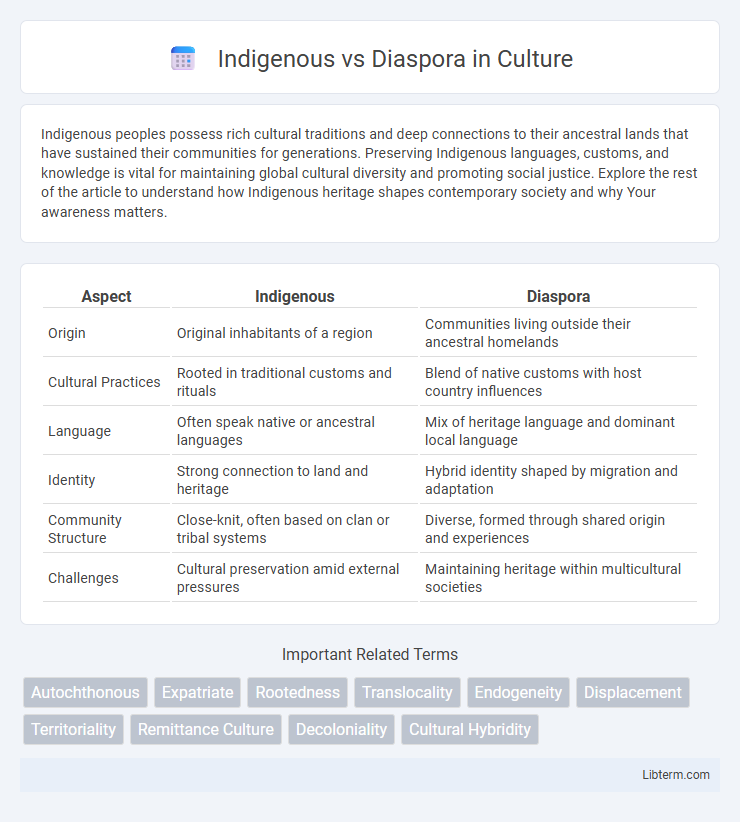Indigenous peoples possess rich cultural traditions and deep connections to their ancestral lands that have sustained their communities for generations. Preserving Indigenous languages, customs, and knowledge is vital for maintaining global cultural diversity and promoting social justice. Explore the rest of the article to understand how Indigenous heritage shapes contemporary society and why Your awareness matters.
Table of Comparison
| Aspect | Indigenous | Diaspora |
|---|---|---|
| Origin | Original inhabitants of a region | Communities living outside their ancestral homelands |
| Cultural Practices | Rooted in traditional customs and rituals | Blend of native customs with host country influences |
| Language | Often speak native or ancestral languages | Mix of heritage language and dominant local language |
| Identity | Strong connection to land and heritage | Hybrid identity shaped by migration and adaptation |
| Community Structure | Close-knit, often based on clan or tribal systems | Diverse, formed through shared origin and experiences |
| Challenges | Cultural preservation amid external pressures | Maintaining heritage within multicultural societies |
Understanding Indigenous and Diaspora: Definitions and Distinctions
Indigenous peoples are ethnic groups native to a particular region or country, possessing distinct cultural, historical, and ancestral ties to their ancestral lands, whereas diaspora refers to communities of people who have spread or been dispersed from their original homeland to other regions globally. The key distinction lies in the Indigenous people's direct connection to their ancestral territory and long-standing cultural traditions, while diaspora communities maintain cultural identity despite geographic displacement. Understanding these definitions helps clarify the socio-political and cultural challenges faced by both Indigenous populations and diaspora groups in preserving their heritage and rights.
Historical Context: Origins and Migration Patterns
Indigenous populations trace their origins to ancestral lands with continuous, long-standing habitation, deeply rooted in specific regions predating modern nation-states. Diaspora communities emerge from forced or voluntary migration, resulting in dispersed populations maintaining cultural identity outside their original homelands. Historical migration patterns reflect colonialism, trade, and conflict, shaping the distinct experiences and identities of both Indigenous peoples and diasporic groups.
Identity and Belonging: Navigating Multiple Cultural Worlds
Indigenous identity is deeply rooted in ancestral lands, traditional customs, and communal ties, fostering a profound sense of belonging within specific territories. Diaspora communities negotiate their identity through a blend of heritage preservation and adaptation to new cultural environments, creating hybrid identities that bridge multiple worlds. Navigating these complex cultural landscapes involves balancing the continuity of original traditions with the influences of host societies, shaping dynamic expressions of self and community.
Language Preservation and Shift in Indigenous and Diaspora Communities
Language preservation in Indigenous communities often relies on intergenerational transmission and cultural practices rooted in specific territories, fostering a strong link between language and identity. Diaspora communities face unique challenges like language shift due to assimilation pressures and limited access to native-language resources, resulting in varying degrees of linguistic retention or loss. Both contexts underscore the critical role of community-based initiatives and digital technologies in revitalizing endangered languages and promoting multilingualism.
Tradition and Change: Cultural Practices Across Borders
Indigenous communities maintain cultural practices deeply rooted in ancestral lands, preserving traditional ceremonies, languages, and arts that signify their identity and connection to the environment. Diaspora populations adapt these traditions by blending native customs with influences from host countries, creating dynamic cultural expressions that evolve across borders while sustaining heritage. This interplay between preservation and transformation highlights the resilience and diversity of Indigenous cultures globally.
Power Dynamics: Marginalization and Representation
Indigenous communities often face systemic marginalization due to historical and ongoing colonial power structures that limit their political representation and control over resources. Diaspora populations experience complex power dynamics as they navigate identity preservation while accessing socio-economic opportunities in host countries, sometimes gaining more visibility but still encountering exclusion. Both groups struggle with underrepresentation in mainstream media and governance, though Indigenous peoples frequently confront direct sovereignty challenges tied to land and cultural rights.
Community Building: Connections Within and Across Homelands
Indigenous communities emphasize deep-rooted connections to ancestral lands, fostering collective identity through traditional practices and shared stewardship of natural resources. Diaspora communities build bridges across global homelands by maintaining cultural rituals, language preservation, and transnational networks that strengthen social cohesion. Both approaches contribute to community resilience by blending place-based heritage with adaptive strategies spanning multiple geographies.
Political Engagement and Activism: Voices from the Margins
Indigenous political engagement centers on sovereignty, land rights, and cultural preservation, often challenging colonial legacies through grassroots activism and community-led movements. Diaspora communities engage politically to combat marginalization, advocate for immigrant rights, and influence host-country policies while maintaining transnational ties to their homelands. Both groups amplify voices from the margins by addressing systemic inequalities and fostering solidarity across diverse political and social struggles.
Challenges of Assimilation, Integration, and Resistance
Indigenous communities face challenges in preserving cultural identity amid pressures of assimilation imposed by dominant societies, often resulting in loss of language and traditional practices. Diaspora populations encounter integration difficulties, balancing the need to adapt to new social norms while resisting cultural erasure. Both groups employ various forms of resistance, including cultural revitalization and political activism, to counteract marginalization and maintain their distinct identities.
Future Perspectives: Sustaining Heritage in a Globalized World
Indigenous communities emphasize the preservation of ancestral knowledge and land stewardship as vital to sustaining cultural heritage amidst globalization. Diaspora populations leverage transnational networks and digital platforms to maintain cultural identity and promote cross-cultural exchange across borders. Future strategies involve collaborative efforts between Indigenous peoples and diaspora groups to ensure dynamic heritage preservation and adaptive cultural resilience.
Indigenous Infographic

 libterm.com
libterm.com